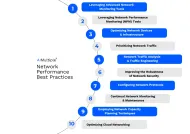15+ Network Performance Statistics in 2024
Network monitoring and performance management are more critical than ever for maintaining seamless operations and ensuring optimal performance. This article delves into 15+ essential network performance statistics that highlight the significance and impact of network monitoring and performance monitoring on businesses and IT infrastructures worldwide.
If you are looking for network performance metrics, you should read our article on this topic.
The state of the network monitoring market
1- Network monitoring market size is projected to reach 3 billion dollars by 2027, to grow at a CAGR of 5-10%.1
2- North America dominated the global market with a share of 42.43% in 2022.2
3- With COVID-19 and switch to remote working, overall network traffic increased by 49% from January 2020 to May 2020.3
4- In 2023, HPE Aruba Networks led the global network hardware industry as the top technology with a market share of 56 percent.4
Network security statistics
5- In the finance industry, 1,832 network security incidents with 480 confirmed data disclosure occurred in 2023.5
6- According to recent research, cybercriminals can reliably penetrate 93 percent of organizations’ networks. Additionally, the emergence of AI has made these attacks less detectable.6
7- ~95% of executives place a high priority on IT security resilience.7
Network downtime statistics
8- According to Uptime’s 2022 Data Center Resiliency Survey, networking-related problems have been the single biggest cause of all IT service downtime incidents – regardless of severity – over the past three years. Outages attributed to software, network and systems issues are on the rise due to complexities from the increasing use of cloud technologies, software-defined architectures and hybrid, distributed architectures.8
9- Half of the server failures cause staff to work overtime, further decreasing the bottom line.9
10- 40% of IT respondents reported that one hour of downtime on their network would cost around US$1 million.10
Network performance statistics
11- 80% of the IT professionals in the defense sector report that reducing the complexity of their network was of high importance.11
12- Implementation of network performance monitoring tools can reduce troubleshooting time by 80%.12
13- Network management solutions are able to improve resource availability by 25%.13
14- 83% of IT pros say they don’t have the WAN visibility they need to effectively troubleshoot problems.14
15- 45% of IT professionals don’t know the full configuration of their network.15
16- Almost 10% of IT professionals plan to invest in network performance monitoring tools in the next 12 months.16
FAQs
What is network monitoring and network performance monitoring?
Network monitoring is the continuous observation of a network’s health, functionality, and performance, ensuring that all interconnected systems and services operate as expected. It involves tracking various aspects of the network metrics and network infrastructure, including hardware (routers, switches, servers) and software operations.
Network performance monitoring (NPM) is a subset of network monitoring focused specifically on measuring network performance, by analyzing network performance monitoring metrics. To measure network performance, it is crucial to monitor network traffic, analyze data packets, and assess network performance metrics such as network latency, bandwidth usage, and packet loss.
The goal of network performance monitoring is to identify, diagnose, and resolve issues like network congestion, optimize network performance, and ensure a smooth and efficient network operation.
Why do businesses need network monitoring solutions?
Businesses require network monitoring solutions to maintain optimal performance and reliability of their network infrastructure, which is crucial for day-to-day operations and long-term success. These solutions help in:
1- Ensuring Continuous Uptime: By monitoring network performance metrics, businesses can prevent downtime, which could lead to significant financial losses and damage to reputation.
2- Optimizing Network Performance: Identifying and resolving issues like network congestion and high latency ensures efficient network traffic flow and improves overall performance.
3- Enhancing Security: Network monitoring helps detect unusual activity that could indicate security breaches or vulnerabilities.
4- Improving Decision Making: Comprehensive network performance measurement provides valuable insights for strategic planning, infrastructure upgrades, and investment decisions.
5- Supporting Growth: Effective network monitoring solutions scale with the business, accommodating increased data packets and expanded network infrastructure without compromising performance.
Which are the best network monitoring tools?
The “best” network monitoring tools often depend on specific business needs, including the size of the network, the complexity of the infrastructure, and budget considerations. However, some widely recognized and highly regarded network monitoring tools include:
– AKIPS
– Solarwinds
– Auvik
– Datadog
– ManageEngine
– NinjaOne
– Atera
For a detailed evaluation and comparison of these tools, you can check our vendor selection article.
How to decide which network monitoring solution to choose?
Deciding on a network monitoring solution involves considering several key factors to ensure it meets your specific requirements for measuring and optimizing network performance:
1- Scope of Monitoring: Determine what aspects of your network need monitoring—just the performance metrics, or a broader range of elements including security and hardware health.
2- Scalability: Choose a solution that can grow with your business, handling increased network traffic and expanding network infrastructure seamlessly.
3- Usability: Consider the ease of setup, use, and maintenance. A user-friendly interface can significantly reduce the learning curve and operational overhead.
4- Integration Capabilities: The tool should integrate well with other systems and tools in your IT environment for a cohesive monitoring strategy.
5- Customization and Flexibility: Look for solutions that offer customization options to tailor the tool to your specific network monitoring and performance measurement needs.
6- Cost: Evaluate the total cost of ownership, including licensing, setup, and ongoing operational costs, to ensure it aligns with your budget.
7- Support and Community: Consider the level of vendor support available and whether there’s an active community for sharing insights and troubleshooting tips.
For more on network performance monitoring
- Top 5 Network Performance Monitoring Tools
- Top 5 Network Traffic Analysis Software Based on 1.3k Reviews
- Top 5 WAN Monitoring Software in 2024 based on 800+ Reviews
- LAN Monitoring Software in 2024: Functions, Features & Top 5 Tools
- Top 7 Network Monitoring Software/Network Management Software based on 3K+ Reviews
If you have questions or need help in finding vendors, feel free to reach out:
External Links
- 1. “Network Monitoring Market Size & Share | Industry Report, 2022-2027.” MarketsandMarkets. Accessed 26 February 2024.
- 2. “Network Monitoring Market Size, Share | Growth Report [2030].” Fortune Business Insights. Accessed 26 February 2024.
- 3. “Network Monitoring Market Size, Share | Growth Report [2030].” Fortune Business Insights. Accessed 26 February 2024.
- 4. “Global network hardware market share 2023.” Statista, 29 January 2024. Accessed 26 February 2024.
- 5. “2023 Data Breach Investigations Report.” Verizon. Accessed 26 February 2024.
- 6. “2023 Network IT Management Report.” Auvik Networks. Accessed 26 February 2024.
- 7. “Security Outcomes Report, Volume 3.” Cisco. Accessed 26 February 2024.
- 8. “Uptime Institute’s 2022 Outage Analysis Finds Downtime Costs and Consequences Worsening as Industry Efforts to Curb Outage Frequency Fall Short.” Business Wire, 8 June 2022. Accessed 26 February 2024.
- 9. “White Paper – The State of Data Protection and Disaster Recovery Readiness: 2021.” Zerto, 1 April 2021. Accessed 26 February 2024.
- 10. “How Much Does 30 Minutes of Network Downtime Cost You?” LinkedIn, 2 February 2022. Accessed 26 February 2024.
- 11. “Survey Report | Shaping the future of IT in defence 2021.” SolarWinds. Accessed 26 February 2024.
- 12. “KHS Manufacturer Takes Advantage of Network Management Software.” WhatsUp Gold. Accessed 26 February 2024.
- 13. “Texas State Guard Prepares for Any Emergency with WhatsUp Gold.” WhatsUp Gold. Accessed 26 February 2024.
- 14. “22 Network Industry Statistics to Use and Share.” Auvik Networks. Accessed 26 February 2024.
- 15. “2023 Network IT Management Report:.” Auvik Networks. Accessed 26 February 2024.
- 16. “2023 Network IT Management Report:.” Auvik Networks. Accessed 26 February 2024.

Cem is the principal analyst at AIMultiple since 2017. AIMultiple informs hundreds of thousands of businesses (as per Similarweb) including 60% of Fortune 500 every month.
Cem's work has been cited by leading global publications including Business Insider, Forbes, Washington Post, global firms like Deloitte, HPE, NGOs like World Economic Forum and supranational organizations like European Commission. You can see more reputable companies and media that referenced AIMultiple.
Throughout his career, Cem served as a tech consultant, tech buyer and tech entrepreneur. He advised enterprises on their technology decisions at McKinsey & Company and Altman Solon for more than a decade. He also published a McKinsey report on digitalization.
He led technology strategy and procurement of a telco while reporting to the CEO. He has also led commercial growth of deep tech company Hypatos that reached a 7 digit annual recurring revenue and a 9 digit valuation from 0 within 2 years. Cem's work in Hypatos was covered by leading technology publications like TechCrunch and Business Insider.
Cem regularly speaks at international technology conferences. He graduated from Bogazici University as a computer engineer and holds an MBA from Columbia Business School.
Sources:
AIMultiple.com Traffic Analytics, Ranking & Audience, Similarweb.
Why Microsoft, IBM, and Google Are Ramping up Efforts on AI Ethics, Business Insider.
Microsoft invests $1 billion in OpenAI to pursue artificial intelligence that’s smarter than we are, Washington Post.
Data management barriers to AI success, Deloitte.
Empowering AI Leadership: AI C-Suite Toolkit, World Economic Forum.
Science, Research and Innovation Performance of the EU, European Commission.
Public-sector digitization: The trillion-dollar challenge, McKinsey & Company.
Hypatos gets $11.8M for a deep learning approach to document processing, TechCrunch.
We got an exclusive look at the pitch deck AI startup Hypatos used to raise $11 million, Business Insider.
To stay up-to-date on B2B tech & accelerate your enterprise:
Follow on


Comments
Your email address will not be published. All fields are required.